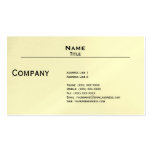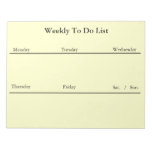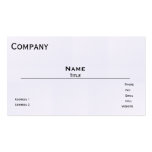As you learned in Marketing 101,
marketing is the process that companies use to get consumers interested in the
items they're selling. Marketing is advantageous to your business for many
reasons. Here are just two of the benefits.
- You alert customers to a product that suits their wants and/or needs.
- Marketing will net your company profits, which will allow you to continue to do business in order to meet future customers' needs.
Marketing efforts are the most successful when they focus on what the consumer wants, not on what you THINK the consumer wants. Having trouble finding out information about your target market? Read this article to learn helpful hints and tips for researching your market.
How Can I Make My Customer Happy While Still Staying True to My Business?
The American Marketing Association (AMA) defines marketing as "the process of planning and executing the conception, pricing, promotion, and distribution of ideas, goods, and services to create exchanges that satisfy individual and organizational objectives." Sounds complicated, but in order to be a successful marketer and businessperson, you'll need to follow a few simple steps:
- Define a target market.
- Discover what products customers in your target market want to buy.
- Set a price for these products.
- Advertise your product to your customers.
- Make your product available to your customers.
What Activities Are Included in Marketing?
Marketing activities are numerous and varied. They include everything necessary to get a product off of a sketch pad and into the hands of consumers. Marketing includes activities such as:
- Designing a product to appear desirable to consumers
- Performing market research and pricing
- Promoting the product through public relations, advertising, marketing communications, and sales and distribution
Marketing requires the orchestration of everyone who plays a role in the common goal of pleasing the customer. If you're a small business owner with no employees, you may need to mentally break down the silos separating core business functions and think more holistically in terms of marketing strategies.
How Can I Incorporate Marketing Into My Company?
General Ideas
- Engage in at least one marketing activity every day.
- Determine a percentage of gross income to spend annually on marketing.
- Set specific marketing goals every year; review and adjust quarterly.
- Carry business cards with you at all times. You never know who you’ll run into!
Target Market
- Stay alert to trends that might impact your target market, product or promotion strategy.
- Read market research studies about your profession, industry, product, target market groups, etc.
- Collect competitors' ads and literature; study them for information about strategy, product features, benefits, etc.
- Ask clients why they hired you and solicit suggestions for improvement.
- Identify a new market.
- Join a list-serve (email list) related to your profession.
- Subscribe to a LinkedIn group or a list-serve that serves your target market.
Product Development
- Create a new service, technique or product.
- Offer a simpler/cheaper/smaller version of your (or existing) product or service.
- Offer a fancier/more expensive/faster/bigger version of your (or existing) product or service.
- Update your services.
Education, Resources, and Information
- Establish a marketing and public relations advisory and referral team composed of your colleagues and/or neighboring business owners; share ideas and referrals and discuss community issues.
- Create a forum or environment for employees to offer their suggestions.
- Attend a marketing seminar.
- Read a marketing book.
- Subscribe to a marketing newsletter or other publication.
- Subscribe to a marketing list-serve.
- Train your staff, clients and colleagues to promote referrals.
- Hold a monthly marketing meeting with employees or associates to discuss strategy and status and solicit marketing ideas.
- Join an association or organization related to your profession.
- Get a marketing intern to take you on as a client; it will give the intern experience and provide you with you some free marketing help.
- Maintain a consultant card file for finding designers, writers, and other marketing professionals. Hire a marketing consultant and conduct several brainstorming sessions.
- Visit another city or county to observe and learn from marketing techniques used there.
Pricing and Payment
- Analyze your fee structure and look for areas requiring modifications or adjustments. Establish a credit card payment option for clients.
- Offer a discount to regular clients.
- Learn to barter. Offer discounts to members of certain clubs/professional groups/organizations in exchange for promotions in their publications.
- Provide cash discounts.
- Offer financing or installment plans.
Marketing Communications
- Publish a newsletter for customers and prospects (it doesn't have to be fancy or expensive).
- Develop an online brochure of services.
- Produce separate business cards/sales literature for each of your target market segments (for example, government and commercial and/or business and consumer).
- Create a poster or calendar to give away to customers and prospects.
- Print a slogan and/or one-sentence description of your business on letterhead, fax cover sheets and invoices. Get your business out on the Internet.
- Create a signature file to be used for all your email messages. It should contain contact details, including your website address and key information about your company that will make the reader want to contact you.
- Include testimonials from customers in your literature.
- Test a new mailing list. If it produces results, add it to your current direct mail lists or consider replacing a list that's not performing up to expectations.
- Announce free or special offers in your direct response pieces. (Direct responses may be direct mail, broadcast faxes, or email messages.) Include the offer in the beginning of the message as well as on the outside of the envelope for direct mail.
Media Relations
- Update your media list often so that press releases are sent to the right media outlet and person.
- Send timely and newsworthy press releases as often as needed.
- Write a column for the local newspaper, local business journal or a trade publication.
- Circulate reprints of published articles.
- Publicize your 500th client of the year (or other notable milestone).
- Create an annual award and publicize it.
- Get public relations and media training or read up on it.
- Appear on a radio or TV talk show…that said, we don’t want to see you on Jerry Springer or Judge Judy.
- Create your own TV program on your industry or your specialty. Market the show to your local cable station or public broadcasting station as a regular program, or see if you can air your show on an open access cable channel.
- Write a letter to the editor of your local newspaper or trade magazine.
- Take an editor to lunch to see what they're writing out and explain how your business might fit in.
- Get a publicity photo taken and enclose with press releases.
- Consistently review newspapers and magazines for possible PR opportunities.
- Submit tip articles to newsletters and newspapers.
- Conduct industry research and develop a press release or article to announce an important discovery in your field.
- Create a press kit and keep its contents current.
Customer Service and Customer Relations
- Ask your clients to come back again.
- Return phone calls promptly.
- Set up an email or fax-on-demand system to easily respond to customer inquiries.
- Use an answering machine or voice mail system to catch after-hours phone calls. Include basic information in your outgoing messages such a business hours, location, etc.
- Ask clients what you can do to help them.
- Take clients out to a ball game, show, or another special event - just send them two tickets with a note. Hold a seminar at your office for clients and prospects.
- Send handwritten thank you notes.
- Send birthday cards and appropriate seasonal greetings.
- Photocopy interesting articles and send them to clients and prospects with a hand-written FYI (for your information) note and your business card.
- Send a book of interest or other appropriate business gift to a client with a handwritten note.
- Create an area on your website specifically for your customers.
- Redecorate your office or location where you meet with your clients.
Networking and Word of Mouth
- Join a Chamber of Commerce or other organization.
- Join or organize a breakfast or lunch club with other professionals (not in your field) to discuss business and network referrals.
- Serve on a city board or commission.
- Host a holiday party.
- Hold an open house.
- Send letters to attendees after you attend a conference.
- Join a community list-serve (email list) on the Internet.
Advertising
- Advertise during peak seasons for your business.
- Get a memorable phone number, such as 1-800-WIDGETS.
- Obtain a memorable URL and email address and include them on all marketing materials.
- Provide Rolodex cards or phone stickers preprinted with your business contact information.
- Promote your business jointly with other professionals via cooperative direct mail.
- Advertise in a specialty directory or in the Yellow Pages.
- Write an ad in another language to reach the non-English-speaking market. Place the ad in a publication that the market reads, such as a Hispanic newspaper.
- Distribute advertising specialty products such as pens, mouse pads, or mugs.
- Mail bumps - photos, samples and other innovative items to your prospect list. (A bump is simply anything that makes the mailing envelope bulge and makes the recipient curious about what's in the envelope!)
- Create a direct mail list of hot prospects.
- Consider non-traditional tactics such as bus backs, billboards, and popular Web sites.
- Project a message on the sidewalk in front of your place of business using a light directed through words etched in a glass window.
- Consider placing ads in your newspaper's classified section.
- Consider a vanity automobile tag with your company name.
- Create a friendly bumper sticker for your car.
- Code your ads and keep records of results.
- Improve your building signage and directional signs inside and out.
- Invest in a neon sign to make your office or storefront window visible at night.
- Create a new or improved company logo or recolor the traditional logo.
- Sponsor and promote a contest or sweepstakes.
Special Events and Outreach
- Get a booth at a fair/trade show attended by your target market.
- Sponsor or host a special event or open house at your business location in cooperation with a local non-profit organization, such as a women's business center. Describe how the organization helped you.
- Give a speech or volunteer for a career day at a high school.
- Teach a class or seminar at a local college or adult education center.
- Sponsor an Adopt-a-Road area in your community to keep roads litter-free. People that pass by the area will see your name on the sign announcing your sponsorship.
- Volunteer your time to a charity or nonprofit organization.
- Donate your product or service to a charity auction.
- Appear on a panel at a professional seminar.
- Write a How To pamphlet or article for publishing.
- Publish a book.
Sales Ideas
- Start every day with two cold calls.
- Read newspapers, business journal, and trade publications for new business openings, personnel appointments, and promotion announcements made by companies. Send your business literature to appropriate individuals and firms.
- Give your sales literature to your lawyer, accountant, printer, banker, temp agency, office supply salesperson, advertising agency, etc. (expand your sales force for free)
- Put your fax number on order forms for easy submission.
- Set up a fax-on-demand or e-mail system to easily distribute responses to company or product inquiries.
- Follow up on your direct mailings, email messages and broadcast faxes with a friendly telephone call.
- Try using the broadcast fax or email delivery methods instead of direct mail (broadcast fax and email allows you to send the same message to many locations at once).
- Use broadcast faxes or email messages to notify your customers of product service updates.
- Extend your hours of operation.
- Reduce response/turnaround time. Make reordering easy - use reminders. Provide pre-addressed envelopes.
- Display product and service samples at your office.
- Remind clients of the products and services you provide that they aren't currently buying.
- Call and/or send mail to former clients to try and reactivate them.
- Take sales orders over the Internet.
Marketing Performance
After implementing a marketing program, entrepreneurs must evaluate its performance. Every program should have performance standards to compare with actual results. Researching industry norms and past performances will help to develop appropriate standards.
Entrepreneurs should audit their company's performance at least quarterly. The key questions are:
- Is the company doing all it can to be customer-oriented?
- Do employees ensure the customers are satisfied and leave wanting to come back?
- Is it easy for the customer to find what he or she wants at a competitive price?








No comments:
Post a Comment